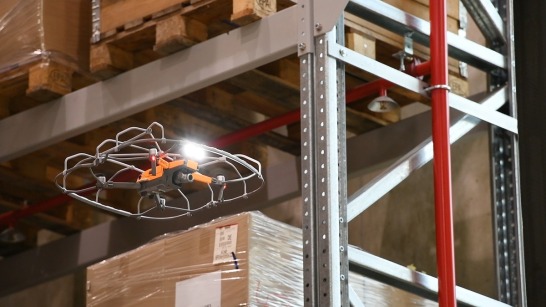If you visit Hall 2C at the Aschaffenburg plant of Linde Material Handling, a KION subsidiary, you will be treated to a rather special performance by “Thelma” and “Louise,” two gigantic shiny white handling robots, which have been hard at work in the automated frame welding system since 2019. They are constantly in motion, collecting, transporting, and depositing the bulky frames and overhead guards within the carefully partitioned production line in fluid movements. The purpose of their perfectly choreographed dance is to move the components along the line from station to station, so that their smaller “colleagues”—28 welding robots and 6 measuring robots—can complete their own stage of the process. All their human colleagues have to do is get the required parts and materials ready—the robots take care of everything else, as the flying sparks and high temperatures are no issue for them.
Maximum Welding Precision and Safety
The dance of the giants is perfectly timed: Every 14 minutes, a frame and overhead guard leave the system, fully welded and carefully checked. While quality control is carried out on a spot-check basis for welding work performed using conventional production methods, the measurement of the finished products is now an integral part of the fully automated process. Every single hole and welded seam is scanned by the measuring robots; the smallest deviation is detected immediately.
“The use of robotics is not only beneficial in terms of process reliability and quality—it also improves health and safety in the plant,” explains Jürgen von Derschau, Head of Global Industrial Engineering and Operational Excellence at KION ITS EMEA. “The hard, physically demanding welding work is performed by machines. This is now the standard not just in Aschaffenburg, but at all KION plants across Europe.”
What’s special about the system in Aschaffenburg, though, is that it is not just the individual welding steps that are fully automated, but all the handling in between as well. “That makes the automated frame welding system here truly ground-breaking and unique in the production of industrial trucks,” says von Derschau. But it will not remain unique, at least not in the KION world. A similarly interlinked system is currently being built at the French KION plant in Châtellerault. This system will complete the entire welding process for the chassis used in the electrical lift trucks produced at that plant.
Fully Automated Production Line for Drive Axles
Around 500 kilometers to the east in the Czech Republic, the fully automated production line has been a fixture at the KION plant near the UNESCO World Heritage Site of Český Krumlov for a long time now. “Český Krumlov is now one of our flagship sites when it comes to robotics and automation,” says von Derschau with a hint of pride. Here, intelligent machines play an important role in many of the processes involved in the production of steering and drive axles for the trucks of the KION Group brands.
The CNC milling machines, for example, which produce the gear shafts, housings, and other subassemblies for the transmission production process are supported by robots—and have been for years. After the highly precise milling has been completed, a robot arm collects the parts and handles various process steps (such as deburring and cleaning the parts) before the parts are conveyed on to the transmission production stage, which is also automated.





_image_546x307.jpg)